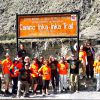Your Checklist for How to Train for Machu Picchu Hiking Tours
It isn’t just an illusion that Machu Picchu looks as though it is suspended above the clouds. This iconic site really is quite high up in the mountains. When you’re about to take off on a journey that will bring you to altitudes higher than 8,000 feet, you can’t be relaxed about preparation. Hiking Machu Picchu is an activity that must be carefully planned months in advance. The fact of the matter is that the decreased oxygen supply at an altitude this high will cause your body to work less efficiently than it normally does. As a result, you will tire more easily and have difficulty maintaining your normal breathing patterns. Taking time to prepare physically and mentally is critical for your safety and performance during your upcoming trip.
Not every trek to Machu Picchu has the same amount of intensity. There are many Machu Picchu hiking tours that vary in difficulty and length. However, all treks require at least a basic level of fitness. The Inca Trail hike is one of the most popular options among today’s tourists. This spectacular hike will take you on a 30-mile odyssey through the Andes Mountains to reach the glory of the Machu Picchu Incan ruins. During the trip, you’ll explore trails that will bring you 13,750 feet above sea level.
In addition to its soaring heights, the journey also consists of challenging and demanding terrain that can make breathing quite difficult. How can you ensure you’ll have the strength to complete the journey? Below is a basic guide for how to properly prepare for hiking Machu Picchu. Following this checklist should leave you perfectly prepared to enjoy the beauty and majesty of the ancient Incan city in the clouds.
Train for Several Months
- Run or ride a bicycle for 30 minutes to an hour three to five days per week. If you don’t regularly exercise, ease into a routine by doing 30 minutes of cardio twice a week.
- Purchase a heart rate monitor from an electronics or sporting goods retailer.
- Run or bike intensely enough to reach 70 percent to 85 percent of your maximum heart rate. Your maximum heart rate can be estimated by subtracting your age from 220.
- Simulate high altitude conditions using an elevation training mask during your training.
- Hike or climb stairs with a heavy backpack at least once per week.
Learn the Best Hiking Practices for Machu Picchu Hiking Tours
- Make a habit of gradually reducing your pace as you gain elevation to prevent your body from overexerting.
- Slow your pace down as soon as you notice that breathing is becoming difficult. Try to match every step with a breath when climbing steep terrain at high altitudes.
Pack the Proper Supplies
- Have plenty of sunscreens to reapply throughout your hike.
- Pack extra clothing to compensate for the fact that temperatures can fluctuate wildly in the mountains.
- Bring utensils, a portable stove, and food if you will be covering a long distance.
- Pack a lot of water.
- Package a tent and sleeping bag if you’ll be spending nights outdoors.
- Pack insect repellent to ward off insects.
Dress Appropriately
- Wear sturdy, tall, and comfortable hiking boots.
- Wear clothing that will be comfortable in the anticipated regional weather conditions.
- Have a hat to protect your head from the sun.
- Wear sunglasses with UV protection.
Acclimate to the Altitude
- Plan your arrival two to five days ahead of the start of your trek. Doing so will help your body properly acclimate to the reduced oxygen levels you’re going to experience.
- If your hike will begin at a lower altitude before climbing to a high altitude, be sure to hike slowly. This strategy will help your body gradually adjust to the spike in altitude.
- Follow the rule that it is best to sleep no higher than 1,500 feet more than you did the night before. This will help you avoid shocking your body.
Be Smart About Sleep
- Eight hours of sleep during training is the rule to follow. Keep in mind that higher altitudes often cause difficulties with sleeping. Being sleep-deprived will make your trek much harder.
- Don’t forget that proper hydration is linked to better sleep.
- Do a practice run by spending a night in your sleeping gear before the trip starts.
- Get earplugs to help you sleep during those windy nights on the trail.
Have Some Medications to Help You Acclimatize
- Plan and pack your own medications and personal medical kit. Tour guides will not be able to provide you with medicine.
- Be sure to consult with your physician and read current literature for the most current advice regarding medications that will help you acclimate. Many physicians recommend taking doses of Diamox or Decadron twice a day in the 24 hours leading up to a trek.

















